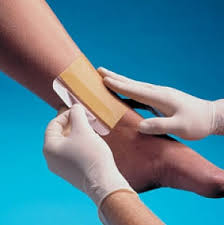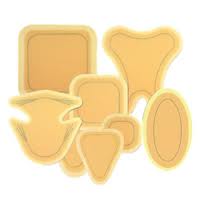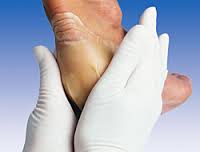
 Reviewed by Christine Kijek, Registered Colorectal Nurse, on December 12, 2022
Reviewed by Christine Kijek, Registered Colorectal Nurse, on December 12, 2022
Introduction | How does it Works? | Size and Shape | When to use? | Application
Dressings play a crucial role in wound management because they are in direct contact with the lesion whose healing will depend to a large extent on how effective the dressing is. The chief functions of a dressing are to stop bleeding, soak up the exudate, protect the wound from infection and promote recovery. Therefore, the right kind of dressing is key for healing.
There are various types of dressings available on the market today and each of them has unique characteristics. There are, for example, dressings which are hydrogel, foam, alginate, silicone, silver, composite, transparent, collagen, hydrocolloid and much more. The list can go on and on because managing wounds can be tough especially if they are chronic and difficult to heal and hence, wound care specialists have come out with different types of dressings each with explicit properties so as to successfully tackle specific types of wounds.

A hydrocolloid dressing is an opaque and adhesive wafer type dressing which is used for dry wounds or wounds with light exudate and is among the most widely used modern dressings. It contains gel-forming agents in an adhesive compound coated onto a flexible, water-resistant outer layer. The hydrocolloid layer is mixed with a combination of absorbent materials such as gelatin, pectin and sodium carboxy-methylcellulose along with other polymers and adhesives to form a non-breathable dressing. Sometimes, an alginate may be included to increase the absorption capabilities of the dressing.
When the polysaccharides and other polymers in a hydrocolloid dressing come in contact with wound exudate, they absorb the water and swell up to form a gel. This gel is immobile and cohesive and held firmly within the structure of the adhesive mass.
This dressing is self-adhering and stays firmly on the wound without requiring any taping though sometimes you may find a dressing with an adhesive border, too. It has the unique feature of being able to adhere to a moist site as well as a dry one.
Hydrocolloid dressing is an occlusive one, which means it is an air- and water-tight dressing that provides a total seal. This property provides a moist healing environment that is known to be beneficial for wound healing. And it keeps the wound bed moist without over-hydrating the lesion. It maintains moist conditions under the dressing thus promoting fibrinolysis (prevention of blood clots from growing), angiogenesis (formation of new blood vessels) and wound healing plus stimulating the production of granulation tissue and increasing the amount of collagen synthesized thus leading to rapid recovery.
Its other properties include management of wound exudate, autolytic debridement, provision of a barrier to micro-organisms and helping with pain management. The moisture retentive property of this dressing helps to gently soften and rehydrate necrotic tissue and slough. It has a softening effect on dry wounds and prevents the spread of MRSA by providing a physical occlusive barrier thus ensuring a greater chance of healing, faster healing times and less pain.
The dressing is resistant to water when intact but once applied onto a wound it absorbs the exudate and becomes more permeable thus being able to cope with exudate production more efficiently. And the gel prevents fluid accumulation on the wound surface.
Hydrocolloid dressing generally overlaps the wound edge and extends onto the surrounding healthy skin thus protecting the healthy peri-wound skin by providing a protective covering. It absorbs the wound exudate, thus keeping the excessive moisture and potentially-damaging proteolytic enzymes away from healthy skin.

A hydrocolloid dressing is available in a variety of shapes, sizes and thicknesses. There are some with tapered edges that make them less likely to wrinkle or roll at the edges.
Selection of the thickness of the dressing will depend on the exudate level. The more the exudate, the thicker will be the dressing. Some thinner dressings maybe semi-transparent thus allowing inspection of the wound.
The size of the dressing should be such that it overlaps onto the surrounding normal skin for about 1.25 inches around the wound.
A hydrocolloid dressing with a slippery backing outer area reduces the coefficient of chafing between the support surface and the patient and thus cuts down further damage to the underlying skin.
This type of a dressing is not designed to be used with a secondary dressing. It is self-adherent and waterproof. With a hydrocolloid dressing, the user will be able to carry out normal daily activities including bathing or showering without affecting the dressing or the wound.
There are many popular brands of hydrocolloid dressings available on the market, like DuoDERM, Comfeel, Restore, RepliCare, Exuderm, Tegaderm, Nu-Derm, and many others.
A hydrocolloid dressing is easy to use and does not require frequent dressing change. It needs to be changed after every 3-7 days depending upon the exudate production. If exudate is heavy, then the dressing may be changed in five days. Otherwise, a hydrocolloid dressing is designed for extended wear for up to 7 days.
Hydrocolloid dressing is widely used in the treatment of pressure ulcers or bed sores. It is increasingly being used in the management of Stage I pressure ulcers and recommended for use in Stage II and III pressure ulcers, too. The moisture control nature of this dressing may have a role in maintaining tissue integrity and preventing deterioration of pressure ulcers by averting maceration.
Hydrocolloid dressings are also useful in the treatment of eczema. It is appropriate for non-infected wounds with light drainage, necrotic or granular wound, dry wound, partial or full thickness wound.

Before applying the dressing to a wound, it should be warmed between the hands. This increases the adhesive power of the dressing and makes it more flexible thus allowing it to conform better to the wound.
Removal of the dressing is easy and without any trauma because of the gel. Unless required to be removed early, removal should be when the gel bubble that forms comes close to the edge of the dressing. Then the removal becomes easy and atraumatic.
Disclaimer: All content found on our website, including images, videos, infographics and text were created solely for informational purposes. Our content should never be used for the purpose of diagnosis or treatment of any medical conditions. Content shared on our websites is not meant to be used as a substitute for advice from a certified medical professional. Reliance on the information provided on our website as a basis for patient treatment is solely at your own risk. We urge all our customers to always consult a physician or a certified medical professional before trying or using a new medical product.